Last Updated on February 25, 2025 by Owen McGab Enaohwo

You recently read that the business process management (BPM) market is expected to record a global growth of 10.5%, reaching $14.4 billion by 2025. So, you are probably convinced that BPM is a big deal for every successful business.
Yet, here you are, feeling like you’re playing a challenging game of chess with your business components scattered across the board. Customer feedback, manufacturing, packaging, storing, marketing, distribution, staff onboarding—each element seems to dance to its rhythm, making the chances of success elusive. Something crucial is missing, leaving you in a perpetual state of puzzle-solving.
Here’s where SweetProcess comes in handy. And if you are curious about what SweetProcess is, it’s not just another Business Process Management Software —it’s your ally in transforming chaos into order. Click here to sign up for a 14-day free trial. No credit card is required, and you’re free to cancel anytime.

What Is Business Process Management? (Types, Examples, and Best Practices) – Table of Contents
What Is Business Process Management (BPM)?
Why Is Business Process Management (BPM) Important for an Organization?
Types of Business Process Management
How to Manage Your Business Processes Using SweetProcess
Case Studies of Businesses Succeeding With SweetProcess
The BPM Lifecycle: 5 Steps in Business Process Management
7 Benefits of Implementing Business Process Management in Your Company
10 Business Process Management Best Practices
Business Process Management Examples and Use Cases From Which You Can Learn
Challenges of Implementing Business Process Management in an Organization
How Business Process Management Differs From Other Process Terminologies
Level up Your Company’s Business Processes Using SweetProcess
What Is Business Process Management (BPM)?
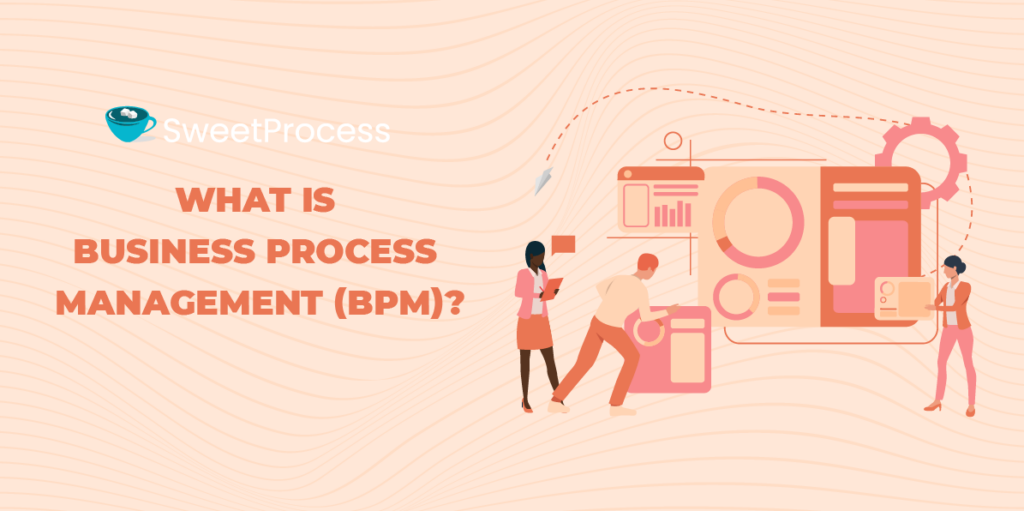
Business process management (BPM) is the structured process businesses and organizations use to get work done, serve their client base, and improve their overall business performance. To better understand BPM, it’s best to see it as a field that cuts across business automation, modeling, control, measurement, and optimization to hit business or organizational goals.
These processes cut across the business system, employees, customers, and associates to achieve set objectives.
Why Is Business Process Management (BPM) Important for an Organization?
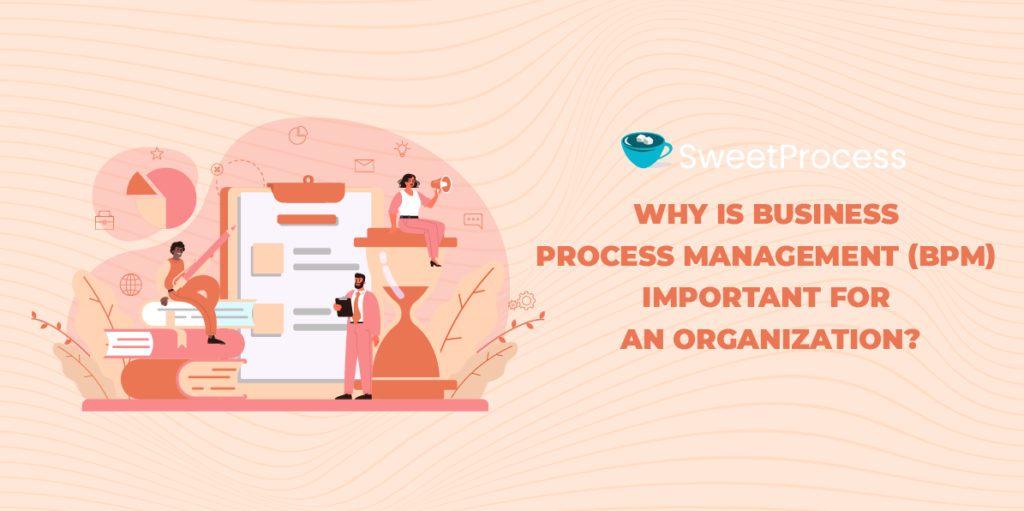
BPM ensures that all the business or organizational operations are geared toward the customer’s needs and helps the business owners and managers use, record, and measure the company’s resources. When done right, BPM will help boost productivity and profitability by reducing cost and time while minimizing risks, errors, and wastages.
Common examples of how BPM helps with business processes include:
Improves Efficiency, Productivity, and Agility
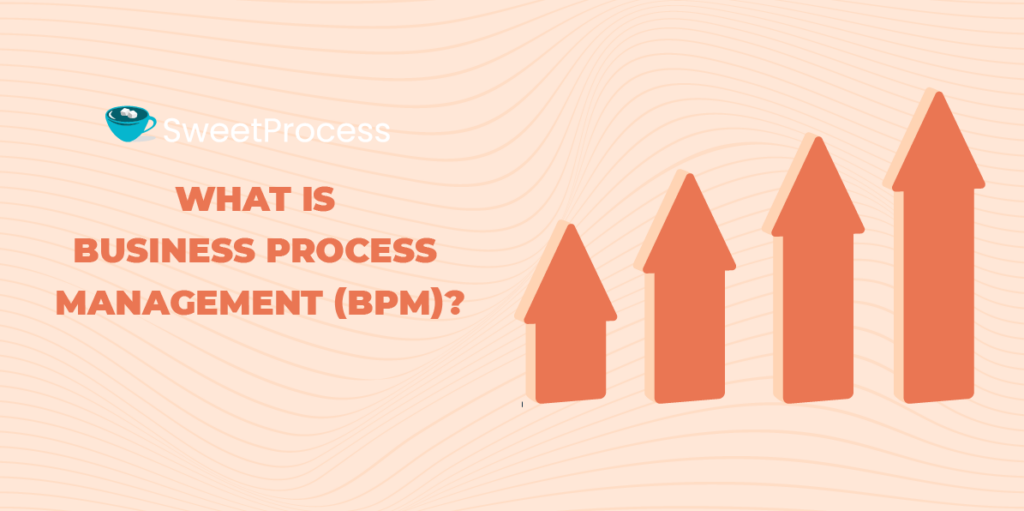
With BPM, your business can significantly improve productivity by documenting, modeling, automating, and optimizing all your repetitive tasks. It helps your manager and employees identify all the bottlenecks in your business processes, foster collaboration, and enhance decision-making.
Reduces Costs and Improves the Quality of Products and Services

A typical example of reducing cost while improving the quality of your product and services is having a well-structured BPM for your onboarding process.
Instead of holding in-person training or presentations when onboarding new staff, why not document all your SOPs and provide detailed and explanatory video tutorials showing the new employees what to do, how to do things, and when? That way, the new staff catches up on all your company’s standard operating procedures without sacrificing the productive hours of any staff member.
The new hire only comes to you with questions while going through the onboarding document and training. These questions, in turn, help you optimize and improve your onboarding process for future hires.
Improves Responsiveness to Changing Customer and Market Needs
Business process management allows businesses and organizations more flexibility and agility with their responses to changing customer and market needs. Your managers can quickly identify roadblocks, and processes and SOPs can be adjusted to meet market demand. Being able to respond swiftly to new business opportunities and challenges may define your business’s success or failure.
Increases Competitiveness and Helps Achieve Long-Term Success
By analyzing and improving business processes, businesses and organizations can attain outstanding operational excellence while delivering higher-quality products and services within the allocated time and budget. It will ensure customer satisfaction and give your company a competitive advantage in the market.
Types of Business Process Management
There are three main types of business process management:
Human-centric BPM
Human-centric BPM is mainly used when humans do the business process. These are business processes that usually require hierarchical employee approval. This type of BPM can be some form of simplified notification and tracking done on a user-friendly platform.
Document-centric BPM
This is the type of BPM deployed when a document is the basis of the business process. This can enhance business processes like document signing, verification, and formatting.
Integration-centric BPM
These are the business processes used in existing software like human resources management systems (HRMS), customer relationship management (CRM), and enterprise resource planning (ERP). This type of BPM is used when there is little to no human involvement in a business process. The process uses some form of software connector or API to make the entire process run smoothly and faster.
How to Manage Your Business Processes Using SweetProcess
Below is a walk-through of the steps to using SweetProcess to manage your business processes. To follow along without feeling lost in a maze, sign up for a free trial of SweetProcess if you haven’t already.

How to Create a Business Process on SweetProcess
Go to SweetProcess.com and submit your email to sign up for a free trial.

Go to your email inbox, look for a confirmation email from team@mail.sweetprocess.com, and click “Verify your email” to complete your free trial sign-up.
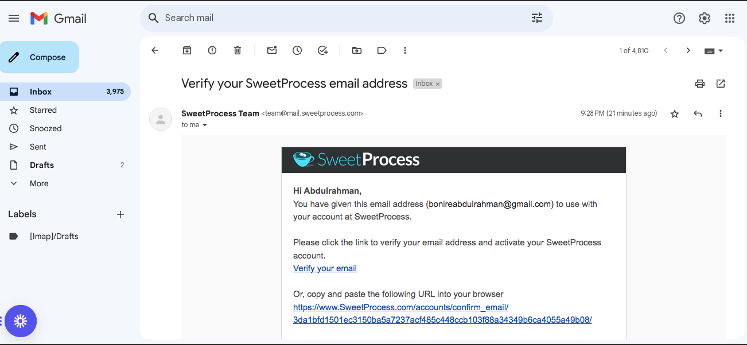
It’ll lead you to your SweetProcess dashboard, a screen similar to the one below.
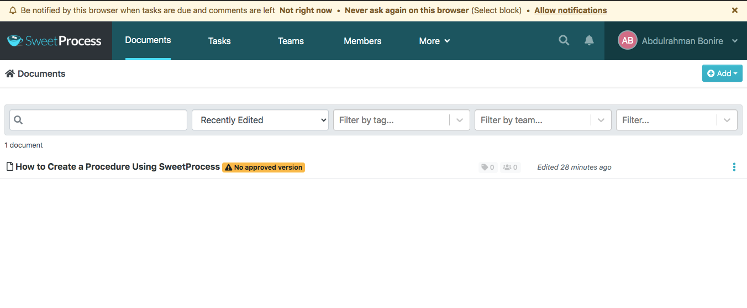
Click on “More.” From the drop-down menu, click on “Processes.” It’ll take you to a screen similar to the one below.
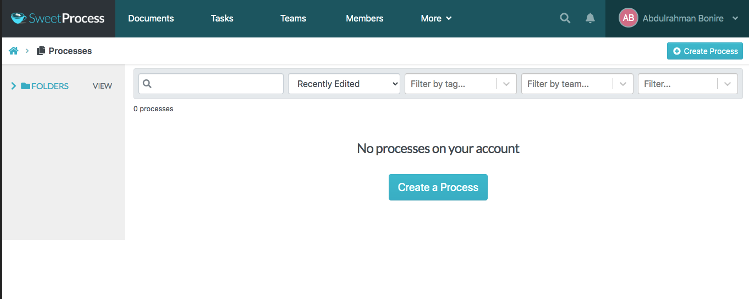
Click the blue “Create a Process” button at the page’s center or top right-hand corner.
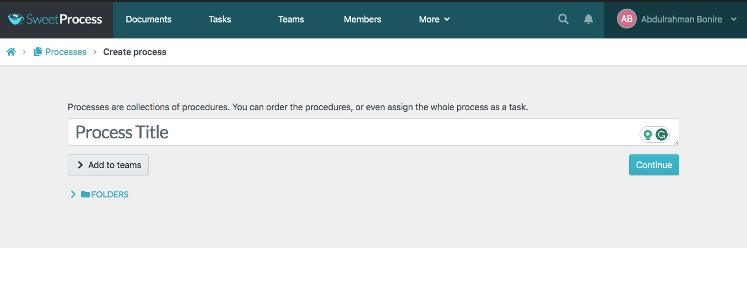
Give your process a name and click “Continue.”
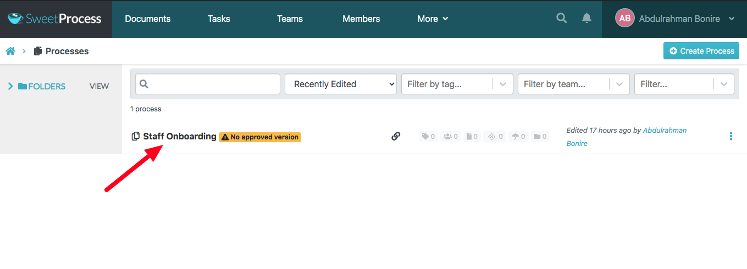
Click on the name of the process, and it’ll lead you to this page below.
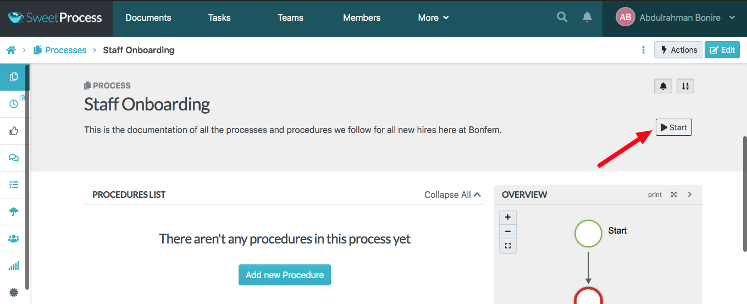
Click on the “Start” button, as indicated in the screenshot above. That should take you to the screen shown below.
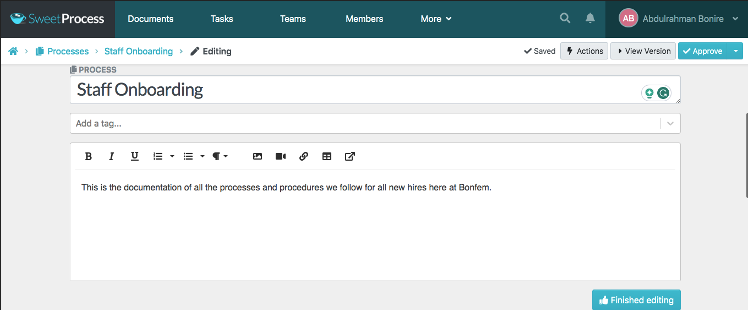
Here, you can edit the name of the process or add instructions. Click “Finished editing” at the bottom right of the screen, then “Approve” at the top right corner.
How to Create a Procedure Using SweetProcess

To add a procedure to your business process using SweetProcess, click the “More” button, as shown in the image above. From the drop-down menu, click on “Procedures.”
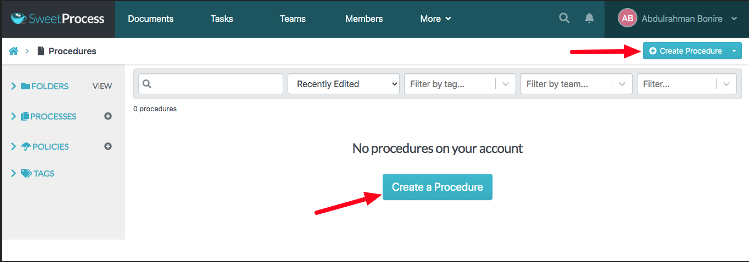
Click “Create a Procedure” at the center or top right-hand corner of the next page, as shown in the image above.
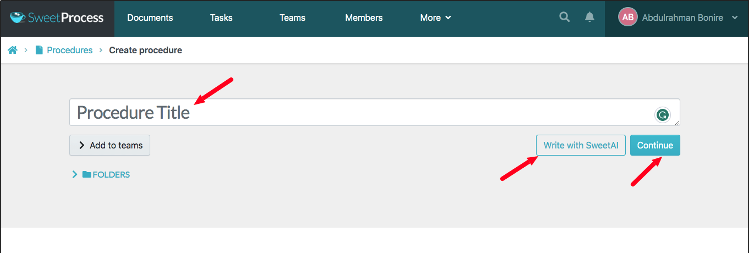
Give your procedure a name and click “Continue” or “Write with SweetAI” and let our Sweet artificial intelligence do its magic by creating the document based on the procedure title.
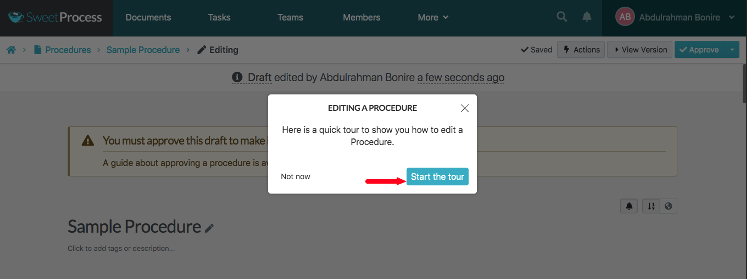
The window that will load is similar to the one above. Since you are still new to the SweetProcess platform, we advise you to “Start the tour,” so the system can show you your way around.
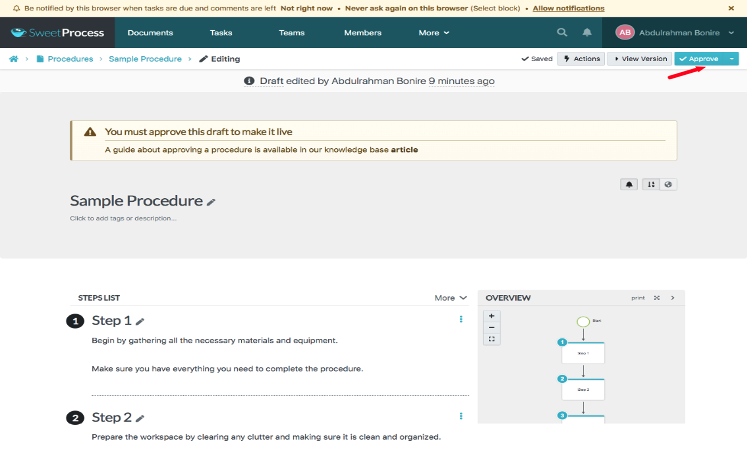
The screenshot above is what a procedure looks like. Here, you can edit the name of each step in the procedure. You can add or remove tags, edit the descriptions, and move each step up or down as you deem fit. The step can also contain images and videos. You must click the “Approve ” button each time you edit to make the edit go live.
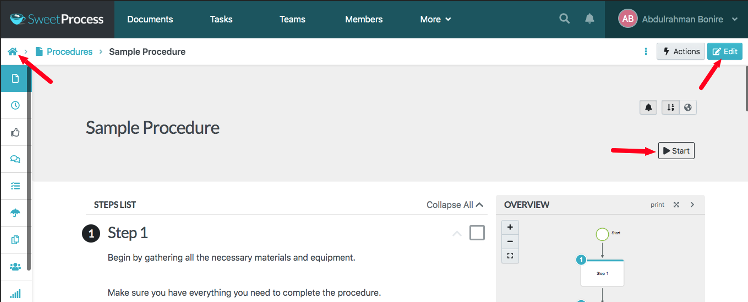
Once all edits are approved, you can click on the “Start” button to start following and checking off each step as they are completed. If you need to edit the procedure, click on the “Edit” button at the top right corner of the page. When you finish the procedure, you can click on the home icon to go back to your dashboard, where you can manage and work with other procedures, just like you have in the screenshot below.

How to Add a Procedure to a Business Process Using SweetProcess
To add a procedure to a business process using SweetProcess, click “More” on the top menu of your SweetProcess dashboard and select “Processes” from the drop-down menu, as seen in the screenshot below.

Your business process or processes (if you have more than one) is displayed below.

Click the process you’d like to add a procedure to. In this example, we’ll click “Staff Onboarding” and “Add new Procedure,” as shown in the screenshot below.
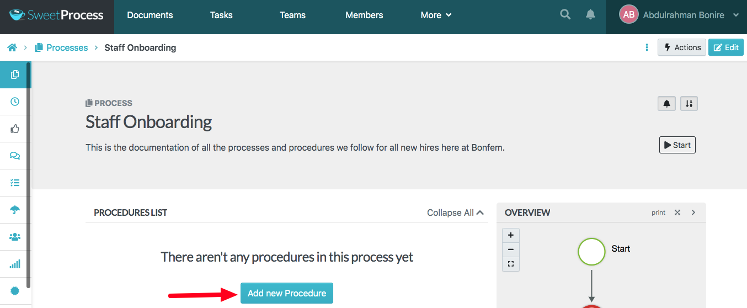
Click on “Add Step” and select “Procedure” from the drop-down menu as shown below.
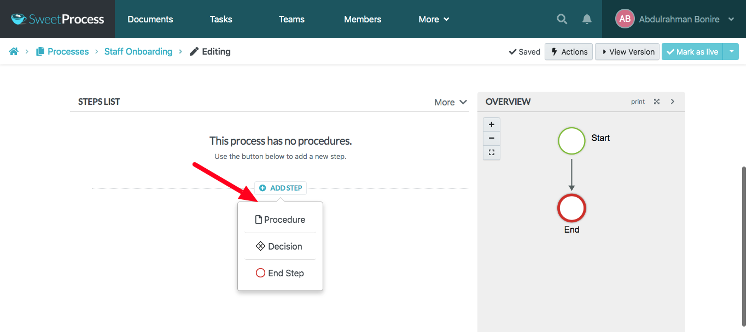
You’ll see a screen similar to the one below. Search the procedure name you’d like to add to the process—in this example, “Sample Procedure.” You can create and add if it’s a new process.
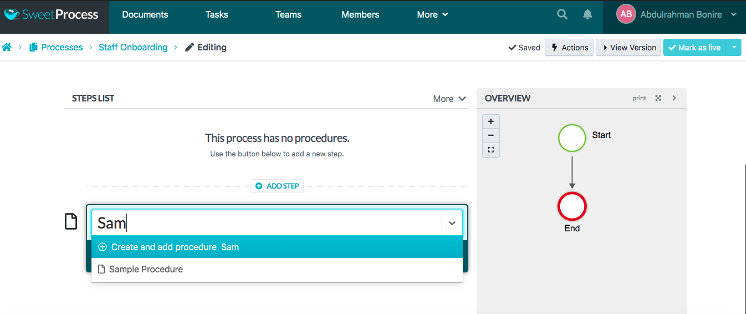
Adding the procedure will take you to a screen like the one below. Click on “Approve”.
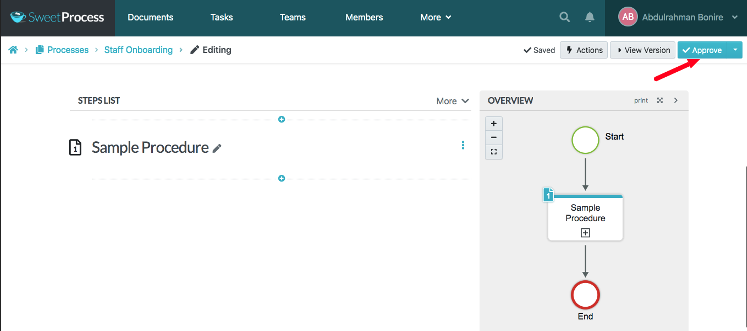
These are the steps to adding a procedure to your business process using SweetProcess.
How to View the Version History of a Process in SweetProcess
From your SweetProcess user dashboard, navigate your way to the “Processes” dashboard by clicking “More” and then “Processes,” as shown below.

Then click on the name of the process in which you want to check the history. In this example, “Staff Onboarding.”

While in the processes dashboard of your account, look to the upper left side of the screen and click on the clock symbol. See the image below.
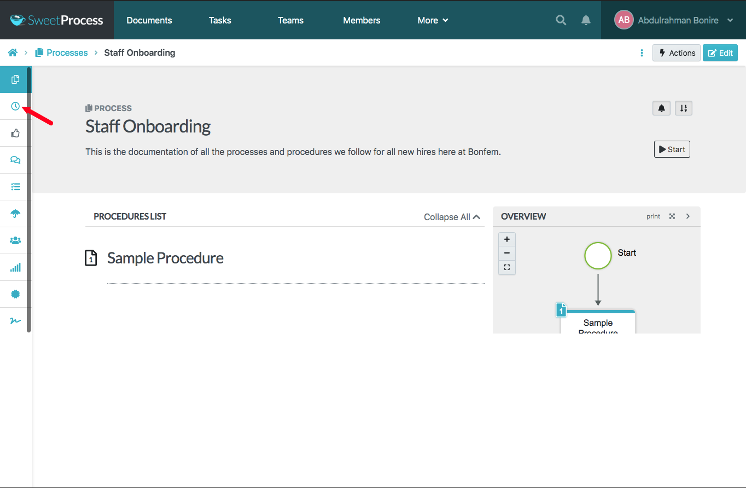
After clicking the clock symbol, you’ll see a dashboard similar to the one below.
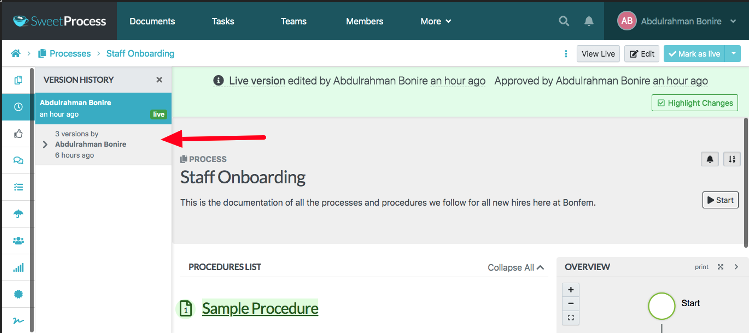
There, you’ll see the current version of the process you are on and all other previous versions.
How to Manage a Business Process on SweetProcess
You can manage your business processes on SweetProcess by logging in to your SweetProcess account and clicking on the three dots at the far right in front of the specific process you’d like to manage.

You’ll see a drop-down menu where you can select from an array of options, like editing the process and tags, adding teams to the process, assigning the process as a task to a team member…and the list goes on.
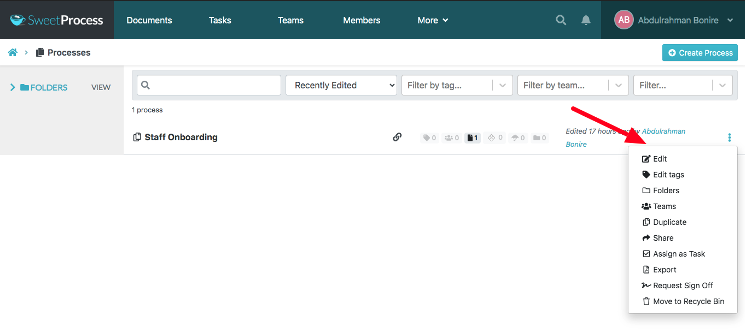
How to Collaborate With Team Members in SweetProcess

To collaborate with team members in SweetProcess, you can create your team and add it to the processes, procedures, and policies you’ll be collaborating with them on. Next, log in to your SweetProcess account. While viewing the process, procedure, or policy you want to collaborate with your team, you’ll find all the collaboration functionality buttons to the left of the screen.
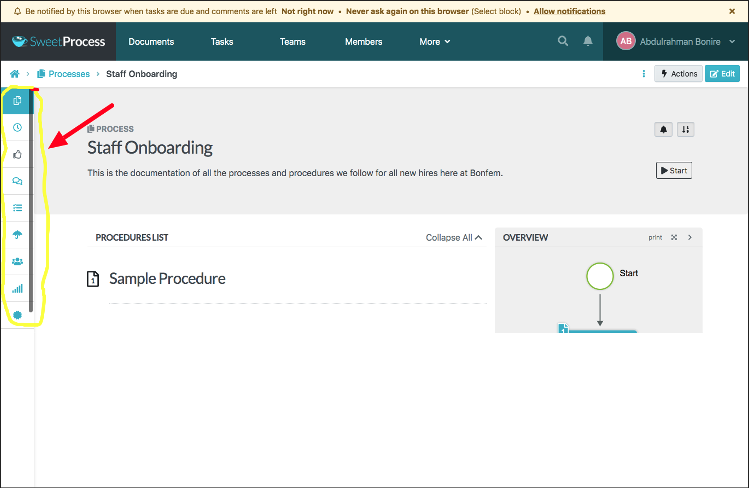
Here, you can view the version history, approve pending approval requests from the collaborating team members, leave a comment for the team or individual members, and lots more.
Case Studies of Businesses Succeeding with SweetProcess

If, like many businesses, you keep running an endless race between your business processes, SweetProcess is the workflow management software you need to put your house in order. Here are some success stories of companies that have recorded successes using SweetProcess.
Case Study 1: Adam Radulovic, CEO of XL.net

Before using SweetProcess, Adam had over 2,000 procedures his company ran on. It took time for him to realize that the less, the merrier it is for his business efficiency and profitability. His employees were in a constant state of confusion as to what works and what doesn’t. Hence, doing the most straightforward task became hard.
There was nothing to show for the effort, money, and time put into his business. For Adam, profit remained elusive. He needed a way out of these chaotic business procedures.
XL.net came upon SweetProcess in a non-traditional manner from a happy customer. Keeping in mind their business’s operational gap, they were eager to get an efficient tool to help them fill it.
The Difference SweetProcess Made for XL.net
Customer satisfaction is critical to every successful business. Adam said their hunger for improved productivity was why they adopted SweetProcess. But did SweetProcess live up to their expectations? Well, Adam was satisfied.
The nature and number of business procedures vary from company to company, but remember, Adam and his staff have over 2,000 procedures they need to chase around to get things done. Managing that procedure manually was a nightmare.
Once they migrated their procedures to SweetProcess, the chaotic procedures vanished into thin air. Their procedures became simplified and manageable. With all staff on the same page and all other parts of the business getting the attention they deserve, XL.net grew in profit.
Case Study 2: Zac Cullen, CEO of Cullen Insurance Agency

Cullen expanded its business by buying related companies. They felt like they had bitten more than they could chew, mainly because of the reluctance of the employees of the newly acquired businesses not wanting to modify their inefficient ways of doing things. It resulted in departments’ incompatibility since their procedures disagreed.
As an expert, Zac knew they couldn’t move forward without resolving this issue and getting everyone to work with the same procedure. All his attempts hit a dead end until he discovered SweetProcess.
The Difference SweetProcess Made for Cullen Insurance Agency
Zac said his SweetProcess helped his business to recover from the chaotic business process and become a front-runner in his field.
SweetProcess helped Cullen Insurance Agency overcome the tedious and mountainous paperwork. With SweetProcess, they have tools for creating charts and other documentation procedures that simplify unnecessary paperwork. Staff can now retrieve files via search in SweetProcess. Zac said it also became more accessible to educate and leave instructions for his employees and for employees to collaborate seamlessly within a team and cross-functionally.
With SweetProcess, Zac and his team also have remote access to any needed files, procedures, and processes. It reduced forgetfulness, mistakes, and common procedural errors that used to be the norm.
SweetProcess has helped Cullen Insurance Agency to record astronomical customer satisfaction, which, in turn, has helped the agency increase its worth to $25,000,000.
If you’ve made it this far and haven’t signed up for SweetProcess, what are you waiting for? Click here to sign up for a free 14-day trial. No credit card is required.
The BPM Lifecycle: 5 Steps in Business Process Management

Simply put, the BPM lifecycle is a framework that allows a business to break down its business process management implementation into five stages: process design, modeling, implementing, monitoring, and continuous optimization to achieve a set goal. Each step in the business process lifecycle builds on the previous one, resulting in an efficient and effective business process management system that meets the business’s operational needs.
Design
The design phase is the foundation of your business process architecture, which allows you to have a holistic view of all your organization’s business processes. At this stage, you identify all the bottlenecks in your business processes and what your business goals are and evaluate how your current processes are performing against the set objectives.
Some essential questions to ask during this stage include:
- What are your current bottlenecks?
- What are your business goals?
- What processes need to be improved?
- How are the processes performing against the current goals?
- Which team is best to handle the process design?
- Which processes need to be discontinued?
- Which new processes need to be introduced?
This design phase usually involves cross-functional teams of stakeholders like the process owners, business analysts, and subject experts. These stakeholders will help map out the expected benefits of the process, time frame, and cost.
Model
The modeling phase of a BPM is the second, and its purpose is to provide a detailed visual representation of the process steps. It will help the stakeholders to understand how things are now (as is) and how you want them to be going forward (to be).
This stage of the business process lifecycle welcomes your creative and innovative ideas, which should pass through the assessment and approval of all stakeholders. For example, if you have some procedures in the process that previously needed manual approval, you can introduce a digital signature to save some time.
Implement
Implementation is the third stage in a BPM lifecycle. In this phase, you set all your designs and models in motion. It can be done in two ways. The systemic approach involves using BPM tools and software like SweetProcess. The non-systemic approach does not involve using these tools and software.
Regardless of what is used, the end goal is to have an improved and efficient business model that will meet your business goals as designed and modeled.
Monitor
The monitoring stage of any business process management lifecycle is when the implementing team looks out for any issues and bottlenecks in the business process while also measuring the whole BPM lifecycle using key performance indicators (KPIs) such as error rate and cycle time.
This monitoring provides valuable feedback, which may inform adjustments to the BPM’s design, model, and implementation.
Optimize
The records generated in the monitoring stage are not for nothing. The optimization phase of a business process management lifecycle is the continuous adjustment, editing, and overall optimization.
Here, you are addressing all the bottlenecks and inefficiencies your customers and employees have identified in your processes and workflow.
Always test your optimized processes on a smaller scale before making it a general change.
7 Benefits of Implementing Business Process Management in Your Company

We are in an unprecedented time. COVID-19 has come and gone, but the pandemic has left us with an increased need for a company-wide BPM adoption. Companies can establish a systemic approach to managing and optimizing their business processes with the right BPM software.
“BPM allows organizations to streamline workflows by automating tedious tasks, such as data management, data flows, data entry approval processes, and report generation,” said Isaac Gould, research manager at Nucleus Research.
Reduces Human Error
Business process management implementation focuses on standardizing business processes to reduce human error. BPM software’s analytic features allow managers to identify redundancies and inefficiencies, which helps employees concentrate on tasks that require human expertise.
More Visibility Into Process Performance
With analytics, charts, collaboration, and notification features and functions of a BPM tool like SweetProcess, business managers can now have a more in-depth view of the business processes and performance, which makes it easier for managers to identify bottlenecks promptly.
Improve Focus on Tasks That Require Human Expertise and Interventions
The process automation functions of BPM software help employees focus on the business activities that require human expertise.
For example, most businesses’ staff onboarding processes can be automated, while the interview process of those hires requires some human interventions and expertise.
Increased Efficiency and Cost Savings

Business process management techniques help streamline business processes and significantly cut operational costs and time, increasing operational efficiencies.
For example, by adopting BPM initiatives, businesses can reduce the time to restock inventory, checkouts, and service time and boost customer satisfaction and profitability.
Less Dependency on Development Teams
BPM provides many features that require little to no code, which helps reduce the dependency of business process teams on the development teams.
Business automation can easily be increased across a company as business customers and users can be onboarded without coding.
Leads to Better Customer Satisfaction

Business process management boosts customer satisfaction by helping companies to deliver high-end services. BPM allows businesses to provide products and services quicker and with less error, leading to happier customers and repeat business.
Improves Efficiency and Effectiveness
Business managers have better visibility of business processes and identify process bottlenecks. The efficiency and effectiveness of business processes can be significantly enhanced thanks to BPM.
10 Business Process Management Best Practices
For you to have and operate holistic and efficient business processes, here are the 10 best practices you should abide by.
Define Clear Goals and Objectives

Before any successful business process management starts, it is essential to identify the existing processes that need to be improved, the expected business outcomes, and the key performance indicators (KPIs) that will be used to measure the process performance.
Involve Stakeholders
Stakeholders’ involvement in any successful business process should be considered. Set the goals from the onset, set a communication schedule, keep track of all milestones, and remove all bottlenecks.
Document and Analyze Processes

Business process documentation and analysis is the complete documentation of a business process using words, diagrams, symbols, videos, and images to map out exactly how a business process should function. How detailed a business process documentation is directly correlated to the success of the business process.
Some of the details that business managers should be captured include:
- The process name
- The process input and output
- The process boundaries
- The process activities and review
- The process organization
- The process roles and chart flows
Use Process Modeling Techniques
Mainly, using process modeling techniques involves using business process modeling and notation (BPMN) standards to understand the nitty-gritty of a business process using graphical representations that communicate the process procedures in a standardized manner.
As a business process modeler who wants to create a BPMN-compliant model, here are some guidelines you should consider.
- Keep a logical and clear sequence
- Use the BPMN standard
- Used detailed labeling
- Use simple diagrams where possible
Continuously Monitor and Measure Process Performance
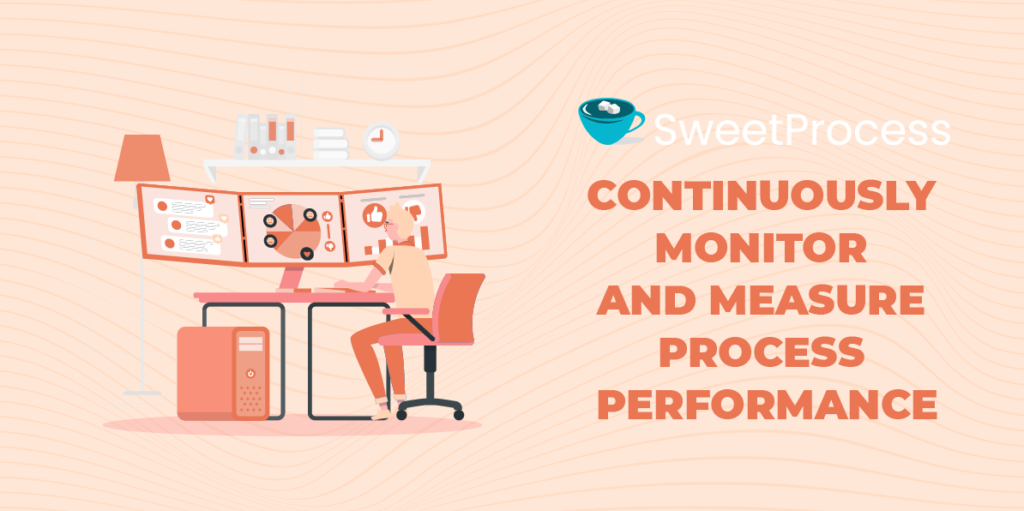
To continuously monitor and measure a business process, you need to:
- Set SMART (specific, measurable, achievable, relevant, and time-bound) goals and objectives
- Taking into consideration the expectations of the stakeholders and customers
- You should also select the right KPIs
- Collect and analyze data
- Communicate the results and recommendations to team members and stakeholders
Use Technology to Automate and Optimize Processes
One of the most significant benefits of business process management is the ability to deploy technological tools to automate and optimize manual and repetitive tasks, which allows employees to focus on more critical parts of the business. To automate and optimize your business process successfully, you’d need to:
- Mark and prioritize processes for automation
- Set clear goals and objectives
- Opt for scalability and flexibility
- Carry the stakeholders along
- Conduct continuous monitoring and optimization of the business process automation (BPA)
- Conduct regular employee training
- Ensure security and compliance
- Seek the guidance of subject expert
Foster a Culture of Continuous Improvement
In fostering a culture of continuous improvement, your goals and targets must be well-defined. What is your business trying to achieve? How is success measured? What are the building principles of your business operations?
- All of these should regularly be spelled out to your employees and stakeholders.
- Ensure everyone is aligned with the business goals and customers’ needs.
- Empower your team with some level of autonomy and authority to experiment. Make it easy for the team to share ideas and feedback.
- Use systemic and proven approaches like Six Sigma, lean, or agile to inform your improvements and innovations.
- Involve your customers by understanding their needs, expectations, and pains. Make it easy to send in their feedback.
- Learning from your previous failures is vital to fostering a culture of continuous improvement. You have to realize that failure is inevitable so you see it as an opportunity to learn, improve, and grow.
- Learn to collaborate with your teams and stakeholders by leveraging their creative and innovative abilities.
Establish a BPM Center of Excellence
Since the introduction of BPM in the business domain, many businesses have seen tremendous growth; many more have also failed. Therefore, it is evident that more is needed to install business process management tool, instruct employees on how to use it, and expect everything to run smoothly.
The question is, what are the successful businesses doing that the failed businesses are not? Establishing a BPM center of excellence (CoE) is critical to business process success.
The steps to establishing a BPM center of excellence are:
- Set the BPM CoE’s scope and success criteria
- Assemble a team with the right skills and expertise
- Establish working standards and guidelines
- Define the process improvement methodology
- Prioritize processes
A good BPM CoE should cater for the following responsibilities:
- Monitor and track the performance of all BPM projects
- Delivering BPM skills and education
- Provide reusable tools and templates
- Establish BPM methodology and best practices
- Ensuring BPM compliance with the set standards and rules
Create Interdisciplinary Teams
Interdisciplinary or cross-functional teams are those comprising experts from different backgrounds and disciplines. As a business executive or manager, you know it’s only possible to accomplish a great goal with an interdisciplinary team to get the job done. Each set of teams needs to come with their expertise before most projects can be completed successfully. But, as with every accomplishment, every opportunity comes with its challenges.
So, how do you build a cross-functional team that will bulldoze workload and deliver results within the allocated time and budget—every single time? Work with the following guidelines in mind, and you should be smiling to a profit.
- Create a clear vision:All team members must understand the project’s exact scope and what you aim to achieve, which is where documentation software like SweetProcess comes in handy.If you haven’t already, sign up for a 14-day free trial here. No credit card is required.
- Create key roles and goals:There must be more than understanding the businessscope and aim alone.Each team and its members must understand their tasks and how they contribute to achieving the company’s goal.
- Provide support: It is essential to have support in place for teams to get the help they need whenever challenges arise.
- Encourage collaboration and creativity:Give your team the autonomy and authority to collaborate and experiment while sharing ideas toward the company’s goal.
- Recognize and reward performance:Ensure you have ways to reward team members individually and collectively to encourage future collaborations.
Use a Formal BPM Methodology
A BPM methodology is the approach you take in your business processes. Whether you have been in business or are just setting out, your business success is in the BPM methodology. You’ll always get great results if you have a robust BPM methodology.
Some of the most popular BPM methodologies you should consider are:
DMEMO (one of the most popular BPM methodologies):
- Design:How things are done to complete your business processes.
- Model:Identify what improvement you can make.
- Implement: Set the adjustment and improvement in motion.
- Monitor:What are the positive results you are getting.
- Optimize:What more can be improved.
DMAIC (One of the most popular Six Sigma methodologies):
- Define:Define the problem.
- Measure:Collect data from the current processes.
- Analyze:Interpret the data and offer suggestions.
- Improve:Make necessary changes to the processes.
- Control: Reduce deviations and make further improvements.
Business Process Management Examples and Use Cases From Which You Can Learn
After over a decade of operation, SweetProcess has served many happy customers across several industries. Below are a few business process management examples and what you can learn from them.
Human Resources
SweetProcess is your process management companion for a seamless staff onboarding process and documenting your business processes, procedures, and policies. SweetProcess also helps you record all your repetitive tasks that would otherwise consume your valuable time. It also gives you the systemization you need to scale your business growth and buys you time to focus on other parts of your business that need your attention.
How Thimbleberry Financial Improved Its Employee Onboarding With SweetProcess

Amy Walls, the president of Thimbleberry Financial, said that as a financial planning and wealth management company, she knows the importance of documenting their processes and procedures. So, she had that done in Microsoft Word.
The problem was that the team needed help with timely access to instructions and information required to do their job. And when they have the instructions, checking off completed tasks is another headache.

That is until Amy’s coach recommended SweetProcess to her. Here are Amy’s words:
“I was looking to solve the communication gap in our processes, and that’s where my business coach said, ‘You need a better documentation system.’ I was reluctant. I didn’t think it was broken, but once I got in there and started plugging in what we had in our Word document, I was like, okay, this is smooth. I can easily reference things.”
After some initial doubt, she took the plunge and has never looked back. Here’s what she said after migrating to SweetProcess:
“I didn’t think it would make that big of a difference. And I didn’t think that checking off things was hard. I didn’t think remembering all the pieces was that hard for our team,” Amy added.
Are you currently experiencing a similar situation in your business and looking to achieve the same transformation in your processes and procedures? Click here to sign up for SweetProcess. It’s free for the first 14 days and requires no credit card.
Customer Service

Documentation of customer service processes can be more important than you can imagine, as it directly relates to improved customer experience. You know it already. Good customer service leads to a better customer experience, which means repeat businesses, more referrals, word-of-mouth marketing, and more profit.
How Preferred Home Services Scaled up by Streamlining Its Operations Using SweetProcess
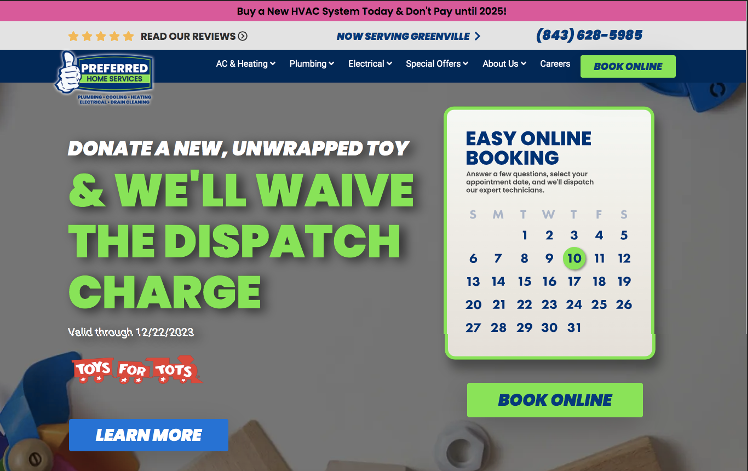
As the new director of marketing and customer experience at Preferred Home Services, Katie Sullivan knew she had to figure out how to streamline the company’s operations.
When Katie joined Preferred Home Services, the company had just started using SweetProcess, but processes and procedures were still everywhere. Sometimes, employees had to chase instructions for two days to learn that the task would take only five minutes.
Why, you ask?
Well, that was because the instructions had to go through more than 12 tables and approvals. And with more than 200 workers, Katie had her hands full. The company had been on the Inc. 5000 list for three years. So, the company’s growth was soaring.

Katie Sullivan, Marketing & Customer Experience Director of Preferred Home Services
Katie sat down and revamped the company’s processes and procedures in SweetProcess. Now, every employee is thankful she did; they can complete their jobs in time because they know when, how, and where the company needs tasks completed.
Here are some of Katie’s words: “When we first signed up, we didn’t understand the power behind SweetProcess. I had started looking at it from a marketing perspective, wanting to document what I was doing. Still, my team quickly grew within a year, and I was like, okay, well, we need to start documenting this because we’re growing and going to grow. You want to take the time to train people on everything you do, but there’s some stuff that you don’t do all the time.”
After fully deploying SweetProcess, Katie said, “If people ask me for assistance sometimes, instead of having to take some 40 minutes to walk them through it, I can send them a link to SweetProcess and say, ‘Here’s what you need to go ahead and get this done.’ We’re able to accomplish a lot more quickly.”
If you’d like to take SweetProcess on a ride but have missed the earlier links, here’s a link to sign up for your 14-day free trial. No credit card is required. And you can cancel anytime, no questions asked.
Sales
The adoption of BPM methodologies is skyrocketing thanks to businesses’ positive results in recent years. Thanks to BPM, sales processes, procedures, and policies can now be streamlined. Staff can accomplish tasks faster and within budget, increasing customer satisfaction and boosting sales.
Some of the benefits BPM has for your sales team include the following:
- Automation of repetitive tasks
- Recreating what works
- Seamless collaboration with your marketing team
- Ease of documenting the sales processes and procedures
Banking
The banking sector is aware of the tremendous impact of adopting BPM on businesses. With the proper business process management structure, banks can automate repetitive tasks like KYC verification, account opening, customer onboarding, credit card processing, loan processing, and regulatory compliance management.
Bank policies and procedures should be standardized, as this will help to ensure proper process management and compliance.
Finance
BPM has a wide array of uses in the financial sector. Some of the most popular uses include decision-making and reporting, among others. Business process management is an integral part of any modern-day financial company. Simply put, BPM deployment in finance is the techniques and methodology structured to improve customer service, cut costs, and increase profit.
Some other benefits of BPM for financial institutions include:
- To improve business agility and flexibility
- To document compliance, safety, and security
- Better visibility of processes, procedures, and policies
- Enhanced customer experience
Challenges of Implementing Business Process Management in an Organization
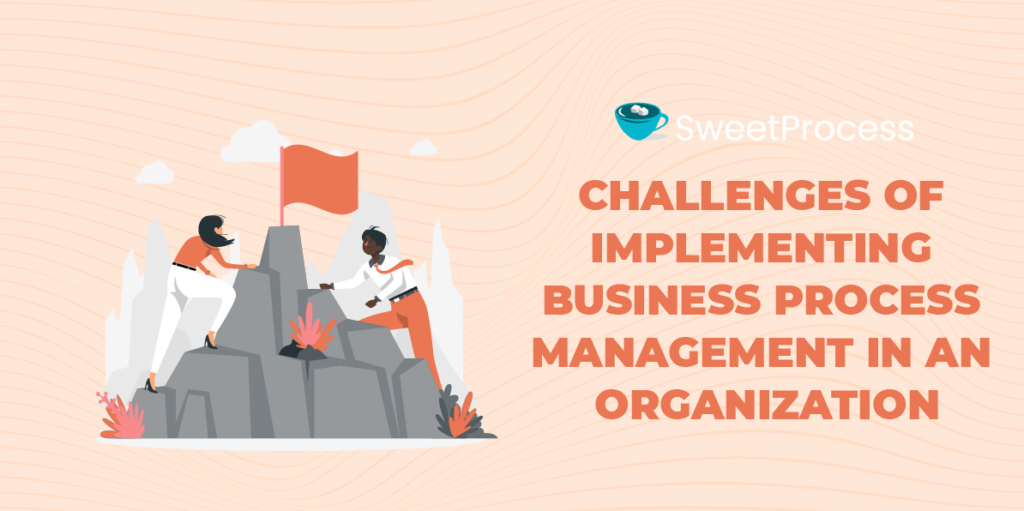
Like every other excellent business initiative, BPM comes with some implementation challenges. Let’s examine a few of them below.
Lack of Executive Buy-in
Making meaningful business changes like BPM without the support of business executives can only remain a dream. For some reason, some stakeholders remain glued to the old ways of doing things, primarily because of the older ways or processes used to deliver outstanding results in the past.
This issue can be solved by aligning the BPM with the company’s goals and showing stakeholders clearly how implementing the BPM initiative will boost the company’s RIO. You can also show them case studies of how adopting BPM has helped many companies grow.
Unclear Business Goals and Objectives
Without clear goals and objectives, getting any BPM initiative to work is nearly impossible. But with clear goals and objectives in mind and a well-structured BPM, businesses can achieve many great results and save money and time.
Inadequate Testing Infrastructures
Implementing business processes may stray into a rough path if they are not passed through appropriate testing. An ill-equipped business infrastructure often needs help to handle BPM initiative’s agility.
So, the adoption of appropriate tools and technologies is non-negotiable. Using an adaptable cloud-based infrastructure like SweetProcess will provide you with all the infrastructures and flexibilities required for testing on a small scale before going company-wide. Sign up for a 14-day free trial without using a credit card.
Hidden Processes Vulnerable to Breakdowns
You can’t fix what you can’t see, right? These hidden processes can break down your process redesigning and re-engineering efforts. Business process analysis and automation will tremendously help uncover all your invisible processes.
Inflexible Third-Party Contracts and Incentives
It would help if you had some flexibility for an efficient and effective BPM deployment. The tendencies of your existing third-party contracts and incentives frustrating your BPM efforts might be some of the biggest challenges you have to overcome. The solution is to foster excellent working relationships with all concerned partners and help them see how adopting these BPM processes will increase efficiency, cut costs, and boost profitability.
How Business Process Management Differs From Other Process Terminologies
In managing business processes, you often use a truckload of terminologies interchangeably. Below, you’ll distinguish between them.
Business Process Management (BPM) vs. Business Process Automation (BPA)
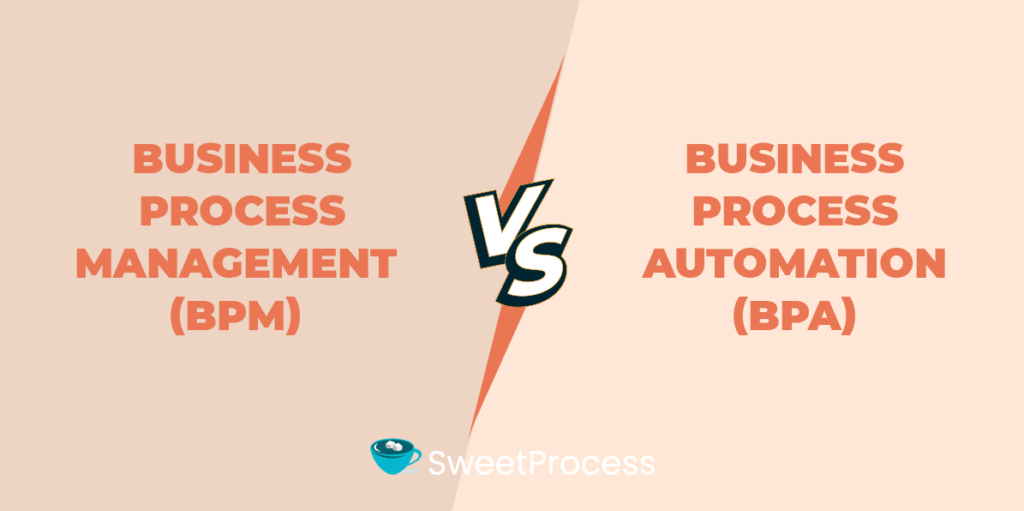
Although Business Process Management (BPM) and Business Process Automation (BPA) may be closely related, they differ. Business process management is creating processes that may or may not involve process automation. Business process automation is the act of creating automated processes.
Business Process Management (BPM) vs. Business Process Improvement
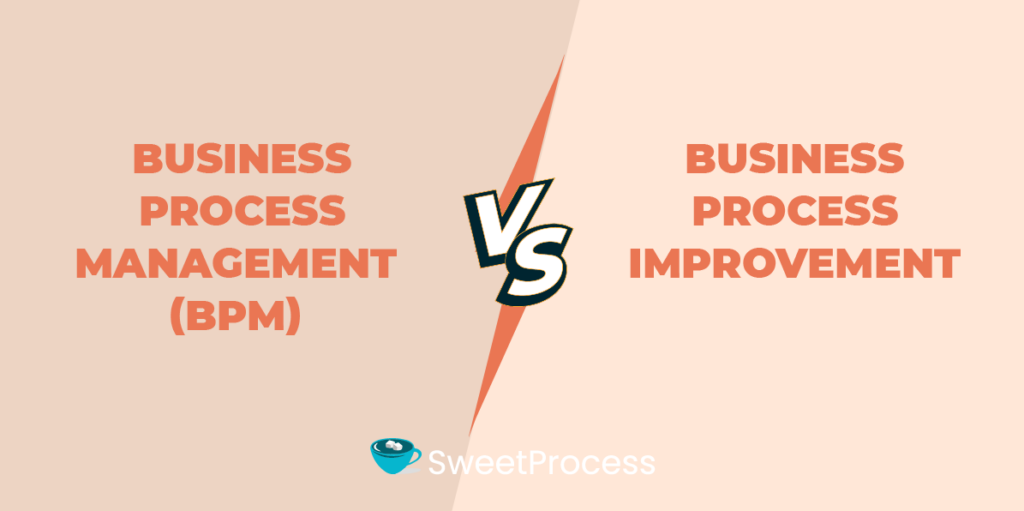
Business process improvement (BPI) aims to improve customer value by continually improving the quality of service, increasing productivity, and reducing costs of business operations. BPI usually deploys well-known methodologies like Lean Six Sigma, Rummler-Brache, and the theory of constraints. Business process management (BPM) is a disciplinary methodology that provides a holistic process understanding, visibility, and control while ensuring effective communication across a company.
Business Process Management (BPM) vs. Project Management
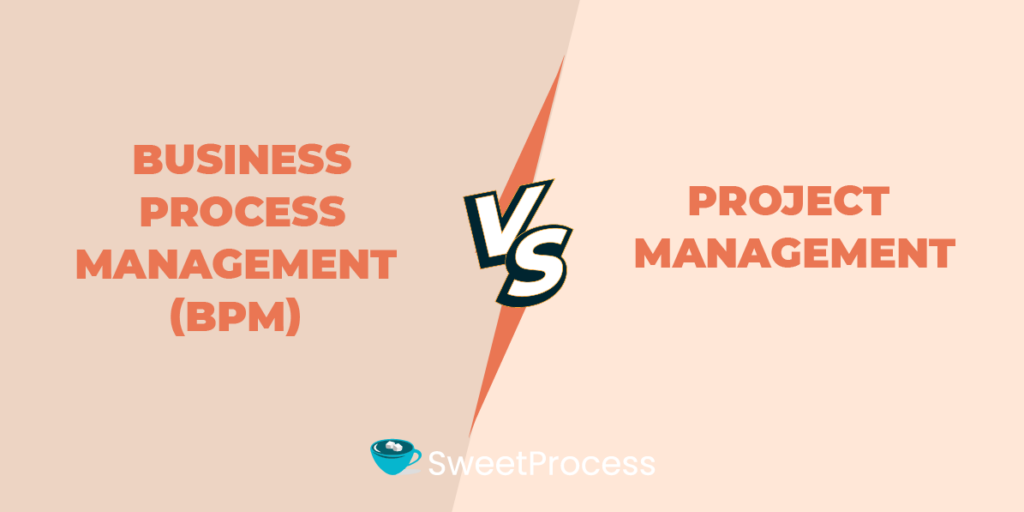
Business process management and project management are closely related yet distinctive concepts that every business manager and chief information officer (CIO) should understand and deploy in their organization.
Business Process Management (BPM) vs. Business Process Re-engineering (BPR)
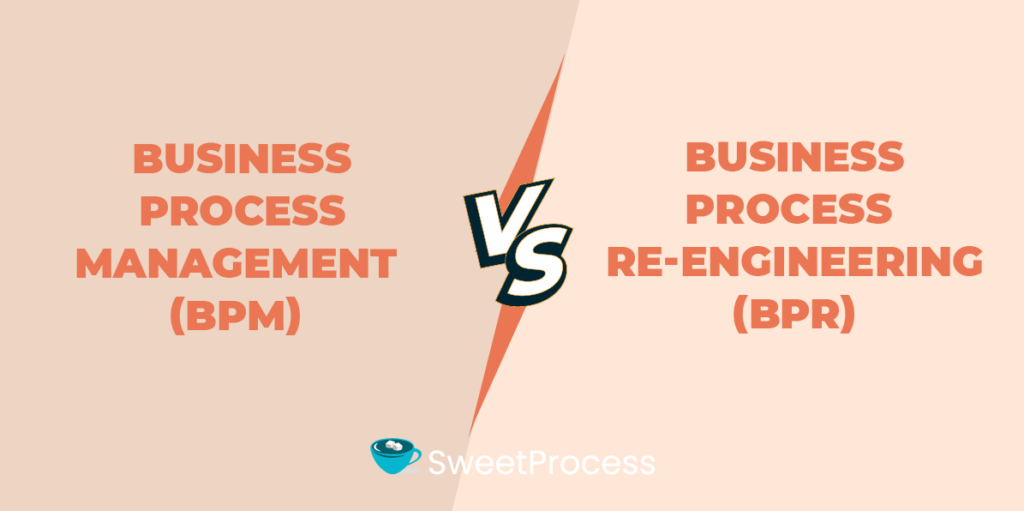
Business process management (BPM) aims to improve a company’s existing business processes. At the same time, Business Process Re-engineering is geared toward improving business processes by implementing entirely new processes to reduce costs, redundancies, and inefficiencies in daily business operations.
BPM increases the visibility into work across business operations, allowing you to align teams and leverage best practices across departments, deploying resources more effectively. Meanwhile, project management processes, in their simplest form, involve organizing tasks in an orderly manner.
Project management can adapt quickly to change by integrating with wherever else the company organizes its operations.
Business Process Management (BPM) vs. Robotic Process Automation (RPA)
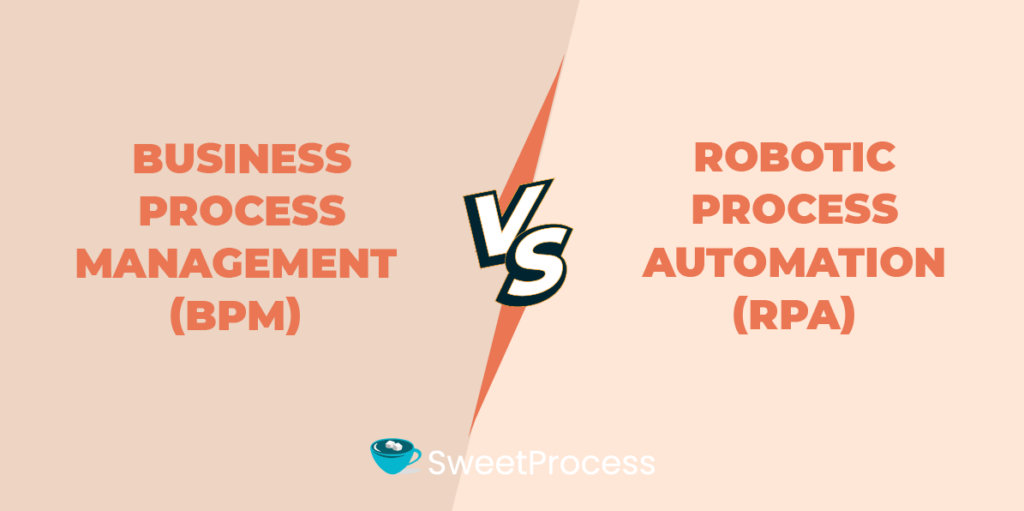
Robotic Process Automation (RPA) is the deployment of programmable BOTs to automate repetitive tasks. BPM comprises several software technology components like analytics, workflow engine, and many more in optimizing business processes to boost value and efficiency.
Level up Your Company’s Business Processes Using SweetProcess
Your business’s effectiveness and efficiency mainly depend on its day-to-day process structure. This structure can either make or break your customer experience and retention, productivity, and profit.
An apt and efficient process management does not have to be complicated or stressful. With the right tool and technology, your transition into the BPM game can be smooth and effortless while learning new things and smashing your business goals.
SweetProcess comes in handy to help you put orderliness into your chaotic business processes. With its simple, user-friendly interface and array of functionalities, SweetProcess can help you ace your business documentation, sharing, and managing of information while tracking the progress of processes every step of the way.
SweetProcess allows you to improve your productivity, efficiency, and profits. Sign up for a 14-day free trial to see how SweetProcess can help your business grow. No credit card is required.
